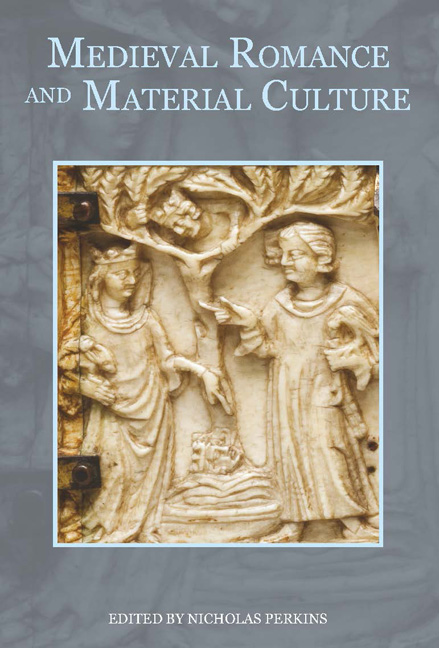Book contents
- Frontmatter
- Contents
- List of Illustrations
- List of Contributors
- Acknowledgements
- Abbreviations
- 1 Introduction: The Materiality of Medieval Romance and The Erle of Tolous
- 2 Courtly Culture and Emotional Intelligence in the Romance of Horn
- 3 Emplaced Reading, or Towards a Spatial Hermeneutic for Medieval Romance
- 4 Devotional Objects, Saracen Spaces and Miracles in Two Matter of France Romances
- 5 The Werewolf of Wicklow: Shapeshifting and Colonial Identity in the Lai de Melion
- 6 ‘Ladyes war at thare avowing’: The Female Gaze in Late-Medieval Scottish Romance
- 7 The Evolution of Cooperation in The Avowyng of Arthur
- 8 Ritual, Revenge and the Politics of Chess in Medieval Romance
- 9 Adventures in the Bob-and-Wheel Tradition: Narratives and Manuscripts
- 10 Reading King Robert of Sicily's Text(s) and Manuscript Context(s)
- 11 The Circulation of Romances from England in Late-Medieval Ireland
- 12 The Image of the Knightly Harper: Symbolism and Resonance
- 13 Carving the Folie Tristan: Ivory Caskets as Material Evidence of Textual History
- 14 Romancing the Orient: The Roman d'Alexandre and Marco Polo's Livre du grand Khan in Oxford, Bodleian Library MS Bodl. 264
- 15 The Victorian Afterlife of The Thornton Romances
- Index
6 - ‘Ladyes war at thare avowing’: The Female Gaze in Late-Medieval Scottish Romance
Published online by Cambridge University Press: 05 May 2015
- Frontmatter
- Contents
- List of Illustrations
- List of Contributors
- Acknowledgements
- Abbreviations
- 1 Introduction: The Materiality of Medieval Romance and The Erle of Tolous
- 2 Courtly Culture and Emotional Intelligence in the Romance of Horn
- 3 Emplaced Reading, or Towards a Spatial Hermeneutic for Medieval Romance
- 4 Devotional Objects, Saracen Spaces and Miracles in Two Matter of France Romances
- 5 The Werewolf of Wicklow: Shapeshifting and Colonial Identity in the Lai de Melion
- 6 ‘Ladyes war at thare avowing’: The Female Gaze in Late-Medieval Scottish Romance
- 7 The Evolution of Cooperation in The Avowyng of Arthur
- 8 Ritual, Revenge and the Politics of Chess in Medieval Romance
- 9 Adventures in the Bob-and-Wheel Tradition: Narratives and Manuscripts
- 10 Reading King Robert of Sicily's Text(s) and Manuscript Context(s)
- 11 The Circulation of Romances from England in Late-Medieval Ireland
- 12 The Image of the Knightly Harper: Symbolism and Resonance
- 13 Carving the Folie Tristan: Ivory Caskets as Material Evidence of Textual History
- 14 Romancing the Orient: The Roman d'Alexandre and Marco Polo's Livre du grand Khan in Oxford, Bodleian Library MS Bodl. 264
- 15 The Victorian Afterlife of The Thornton Romances
- Index
Summary
Throughout the canon of late-medieval Scottish secular writing, love and sex are frequently seen either as trivial distractions from the hero's main business of achieving military victory, or as an active threat to his wellbeing. This is apparent in texts ranging from the history epics The Bruce (c. 1375) and The Wallace (c. 1471–79), in which women and love endanger the heroes’ defence of the nation, to the 1460 Buik of King Alexander the Conquerour, in which Alexander's amorous adventures threaten his mission of conquest. In other Older Scots romances and romance-derived texts, the challenge of love is absent (as in Rauf Coilyear, c. 1475–1500) or, in the case of Gologras and Gawain (also c. 1475–1500), it is removed altogether, even when this involves making significant changes to the romance's French source material. Similar difficulties surrounding love and sex are seen in a number of fifteenth-century Northern English romances, such as the Gawain-romances’ depictions of monstrous brides, brutal relatives and sexuality as a cause of conflict between knights, or the use of adulterous sexual love as a site of rebuke for the characters’ moral failings.
Three Scottish texts depart from these trends. The 1438 Buik of Alexander, the late fifteenth-century Lancelot of the Laik and the sixteenth-century Clariodus are all translated from French sources, and draw upon their presentation of sexual love as a positive motivating force for the knights’ military actions. As Richard Kaeuper comments, this is of course a common pattern in French chivalric literature: ‘the mental—perhaps the glandular—link of sex and violence […] writ large’. However, the decision to maintain this link in the Scottish translations is a somewhat unusual one: as noted above, other contemporary Scottish translators and redactors, including Gilbert Hay and the Gologras-poet, instead choose to omit or drastically reduce their sources’ interests in the amatory.
- Type
- Chapter
- Information
- Medieval Romance and Material Culture , pp. 91 - 110Publisher: Boydell & BrewerPrint publication year: 2015



